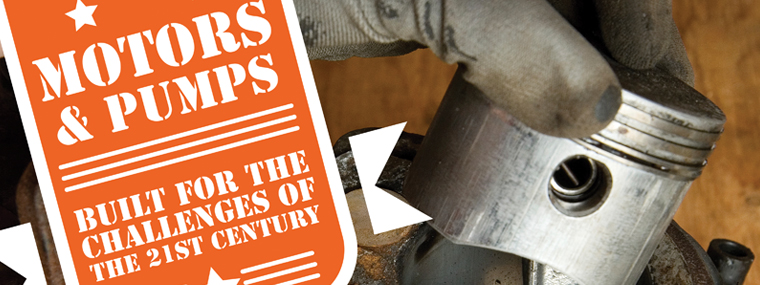
Motors and Pumps: Built for the Challenges of the 21st Century
By Diane M. Calabrese / Published September 2015

P
umps
Which two components of a pressure washer give the machine its essence? Argu-ably, they are the motor and the pump. The motor produces movement. The movement drives the pump. And the pump creates pressure to displace water.
The motor can be powered by an onboard combustion engine that burns diesel or gas fuel. Or, it can be propelled by electric current arriving via a direct connection to the grid.
Movement and pressure propel industry of every sort. From irrigation systems on farms to felling heads on mechanical timber harvesters to heart bypass machines, motors and pumps are inextricably linked. Each industry also has its own accomplishments in ever-better designs of motors and pumps.
Looking at the future of pumps, for example, Al Stasny, technical manager at A.R. North America, Inc. in Fridley, MN, sees no end to the gains. “Innovation is a never-ending journey,” he says. “Basically, over the last decade we’ve been able to shrink the size of the pump,” says Stasny. “Size compression of pumps” is a fascinating lineage in pressure washer development.
Smaller pumps correlate with lower costs. Lower costs in building and operating pressure-dependent machines open new markets. They have been particularly important in the entry of pressure washers into the homeowner market.
Pumps today are durable and reliable. Yet they should not be taken for granted. Maintenance is still the key to longevity.
Too often, a contractor is busy and when a seal needs replacement—as evidenced by a routine maintenance schedule or any leakage, the contractor just does not get to it. “Replace seals when they should be replaced,” says Stasny.
Be sure to check the inlet filtration, also, says Stasny. “Don’t starve a pump for water” because it leads to a cascade of problems that will “create more damage.”
No visible problem should be ignored. “Take care of it sooner rather than later,” says Stasny. Procrastination in looking after equipment is not a viable plan for maintenance.
Stasny cites his company’s XJV model pump as an exemplar of the ongoing refinements in design. The oil-filled axial radial pump for pressure washers is rated to 2.5 gpm at 2200 psi. It has a built-in pressure control valve and chemical injection system.
Contractors value pressure gauges and injectors. They also value machines that consume the least power possible. It’s not just smaller pumps that tamp down power consumption. It’s also putting the cutting-edge principles of fluid dynamics to work inside pumps and doing things like tapping centrifugal force by using an axial design.
We are both a long way from and very close to the water pump that made it possible to run taps to kitchens in the 19th century. Manual operation of a lever attached to a plunger created enough pressure on water in a holding tank to force water out of a second opening, a pipe that served as a tap.
The power source behind the pumps that displace water has changed, but the concept is still the same. In a pressure washer pump, water fills a holding area where it is then displaced and pushed through the orifice to the nozzle (by the action of a mechanized pump). Valves govern inflow and prevent backflow of water.
Motors
According to the U.S. Department of Energy (DOE), some five million motors were shipped in the United States in 2013. How many motors are in use at any given time? It’s difficult to know, but one thing is certain: DOE has a keen interest in promoting efficiency in the motors that keep industrial machines, including pressure washers, operating.
The DOE puts the power consumption of a 30 horsepower electric motor at 62,000 kilowatt-hours per year. [See sidebar.] In 2014, the DOE established new efficiency standards for motors, which aim to reduce consumption and correspondingly cut the emission of carbon.
Making motors that conform and surpass federal standards is now an objective across manufacturers. Com-mitment and ingenuity gird the effort.
The last decade has been a productive one for innovators with a focus on energy conservation. “Electric fuel injection, or EFI technology, is a significant innovation,” says Bill Bussler, a public relations officer in the power group at Kohler Co. in Kohler, WI. “This technology—with roots in the automotive industry—ensures engines provide optimal fuel efficiency, which helps to reduce emissions and provides end users with enhanced engine performance and significant fuel savings.”
As with pump design, changes in engine design often bring a series of related, positive developments for end users. The system that Bussler describes serves as an illustration.
“Our company’s Command PRO EFI Engine is a closed-loop EFI system, which integrates an oxygen sensor in the unit’s muffler that analyzes the air/fuel mixture,” says Bussler. “If the air/fuel mixture strays from the ideal level, the sensor triggers adjustments to the amount of fuel injected into the system. Through this process, our EFI technology always runs an ideal air/fuel mix, which—in addition to optimizing fuel efficiency—also helps to deliver easy starting, improved power, and increased lifespan.”
Easy to start and increased lifespan are sweet words to any contractor. Again, though, there is the risk of taking equipment for granted and neglecting the manufacturer’s maintenance schedule.
What’s too often overlooked? “Probably air filters,” says Bussler. “Most engines today incorporate heavy-duty air filters that perform well over a long period of time. But, despite the longevity, filters still need to be checked regularly and replaced when they’re worn in order to maximize engine performance.”
Like Stasny, Bussler is optimistic about the pace of innovation. And he expects it to be sustained or accelerated.
“In the short term, advancements in technology will continue to enhance fuel efficiency while delivering a better overall experience to end users,” says Bussler. “Engine manufacturers will continue to focus on ways to help commercial users save time and money. It’s all about delivering the best overall value to today’s professionals who are looking for dependable, reliable, high-performing products.”
Energy and Power
The DOE enforces compliance for both energy and water conservation standards that have been established for commercial and industrial equipment (and certain consumer products). DOE has published its certification, compliance, and enforcement regulations in the Code of Federal Regulations (CFR) at 10 CFR 429. In the electronic version of the CFR (e-CFR), there are daily updates.
Manufacturers must follow DOE guidance in establishing certified ratings for equipment. The ratings must be based on DOE test procedures, which in turn derive from a sample of units of a given basic model. Manufacturers must also use the statistical sampling plans prescribed by DOE. Finally, they must submit required certification reports to DOE and maintain records that support the reports.
DOE regulations can seem daunting, but they are not stopping manufacturers from continuing to do what they do best. That’s because manufacturers share the societal goal of efficient use of energy.
In fact, there is a great opportunity for cutting power consumption in the United States by making motors more efficient. According to the DOE, industrial electric motors consume 25 percent of the electricity sold in our nation.
The effort to boost efficiency of industrial equipment extends to building motors and pumps that are specifically intended for use in a particular industry. To which sort of elements will the motor be exposed? Will it be used in a hot or a cold environment? Questions are asked and answered with design modifications.
Heat generated by mechanical action or combustion is not kind to components of motors (or pumps). Engine cooling technologies, such as totally enclosed cooling fans, are part of the picture.
Use less energy. Save money on power. Run a business more efficiently. All are good outcomes. And each one can be tied to motors and pumps built for the challenges of our century.
SI As Impetus For Efficiency Gains?
Although the International System of Units (SI) was established in 1960, the United States has not adopted it for everyday use. (Most manufacturers do use SI.) As a result, different terms for power consumption are used. Horsepower, Btu, and kilowatt (kW) are all in use, as are ergs, kilograms, and calories.
SI provides for only one unit of measure for energy, the joule. And it provides for only one unit of measure of power, the watt.
Power is defined as energy used per unit of time. One watt signifies one joule per second. The watt, then, indicates the rate of consumption of energy. (One horsepower equals 746 watts.)
For whatever reason, it’s difficult for our nation to fully embrace SI. That leads to a great deal of murkiness in terms of comparing efficiencies. For example, in SI, we would refer to energy consumption in joules and compare joules to joules.
Instead, we use a little of this and a little of that when discussing energy and power. Even when we refer to kilowatt-hours, few of us recall the equivalent of one joule to one watt-second. (Again, power is energy used per unit of time, so energy can be expressed as power-time.)




